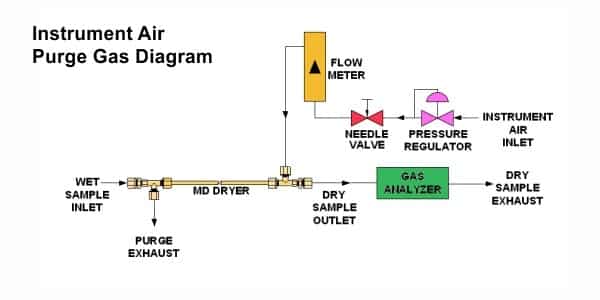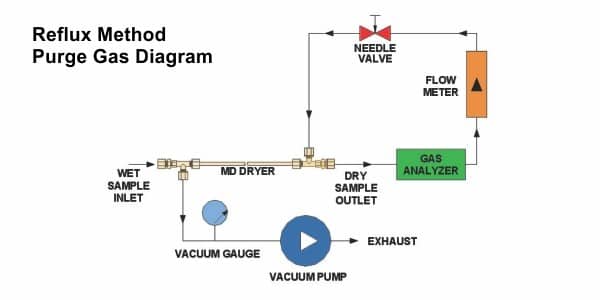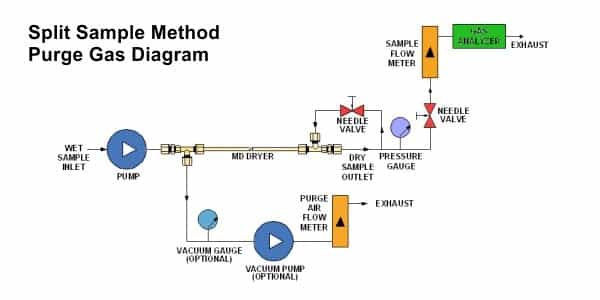Perma Pure Purge Gas Configurations
The MD and PD series have a special tube and shell design developed to be used with a dry purge gas, providing a controlled environment for the moisture transfer to occur. With these products, the end performance is controllable and dependent on the purge gas set up used. In order to get Perma Pure dryers to remove moisture from your gas stream, a gas with lower moisture content than your sample gas must be routed through the purge gas connections on the dryer. This page includes basic purge gas set-ups that have been successfully deployed by Perma Pure customers. For a more comprehensive explanation please download Integrating Perma Pure’s Sample Gas Drying Into Your Equipment.

Instrument Air – Dried compressed or “Instrument” Air is typically found at most industrial plants and in many labs and serves as an excellent purge gas. The dew point of this purge gas is typically -40° to -45°C. Most of our performance curves have been made from test data using instrument air. We recommend the purge gas flow be 1-3x of the sample gas flow for optimal drying performance, depending on your application. It is important to make sure you test to find the optimum performance point for your set up.
Nitrogen or other Cylinder gas – Using dried cylinder gas with a typical dew point of -60° or -70°C can yield even lower results than shown on our performance curves. Often used for lab applications, this method might not be cost effective for continuous or high flow applications. We recommend the purge gas flow be 1-3x of the sample gas flow, depending on your application, depending on your application. It is important to make sure you test to find the optimum performance point for your set up.

Recycled Sample Gas (Reflux) Method – See the diagram above. Where no instrument air is available, the dried sample gas may be used after analysis as the purge gas by piping it in back to the purge gas inlet. For best results, a vacuum should be pulled through the purge gas path by installing the vacuum pump ahead of the purge gas outlet and a flow restriction (a needle valve or capillary tube) before the purge gas inlet. For maximum performance, the vacuum level should be no less than 7 psi (1/2 atmosphere). The performance improves as vacuum deepens. We recommend the purge gas flow be 1-3x of the (nominal) sample gas flow, which can be achieved with the vacuum. It is important to make sure you test to find the optimum performance point for your set up.
Atmospheric Vacuum Method – Similar to the Reflux Method, a vacuum is pulled over the tube as the purge gas, but instead of recycling the sample gas, atmospheric air is used. The same set up would apply (vacuum pump plus flow restriction). The only issue here is that the target dryness of the sample would vary with temperature and moisture level of the atmospheric air being used.
Split Sample Gas Method – See the diagram above. Where no instrument air is available, this method – similar to the Reflux Method described above – can be used. The split sample method channels a portion of the gas being dried back over the Nafion™ tubing as the purge gas. The other portion is routed to the analyzer. A similar set up with the vacuum pump and flow restriction would be created. Because we recommend the purge gas flow be 1-3x of the sample gas flow, the sample gas flow rate required for analysis needs to be increased accordingly, taking the vacuum effect into account. Like with the other methods, it is important to make sure you test to find the optimum performance point for your set up.
Combination Dryer Methods – In order to get to target dryness levels lower than what the Nafion™-based products allow, a combination of dryers is often used. The Nafion™ based dryer can be used as the first dryer stage, removing up to 95% of the moisture in the gas stream. This set-up effectively extends the service life of the secondary desiccant or coalescing filter, greatly reducing costs and extending equipment service intervals.

